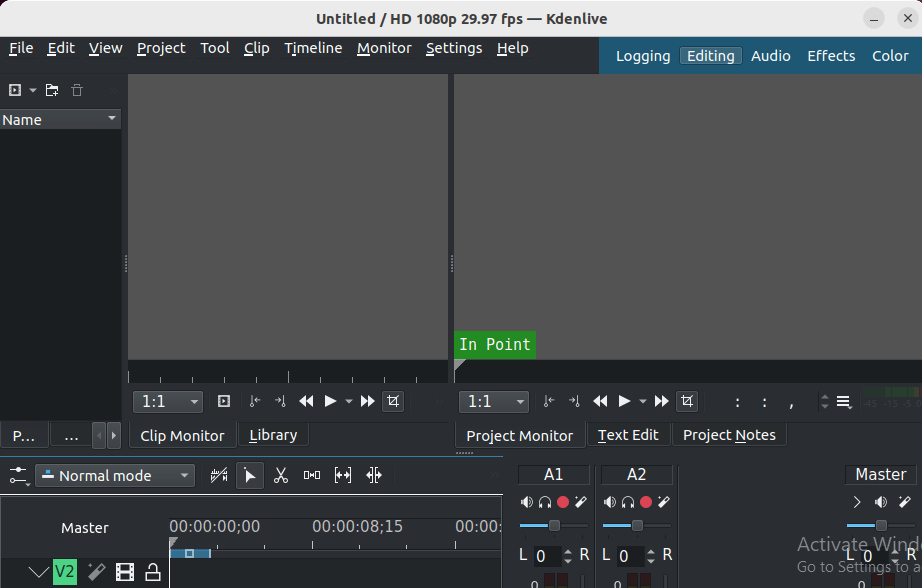How To Install Kdenlive on AlmaLinux 10

In this tutorial, we will show you how to install Kdenlive on AlmaLinux 10. AlmaLinux 10 users seeking professional video editing capabilities will find Kdenlive an exceptional choice. This comprehensive guide explores multiple installation methods to get this powerful, open-source video editor running on your AlmaLinux 10 system. Whether you’re a content creator, professional editor, or Linux enthusiast, Kdenlive offers enterprise-grade video editing tools without licensing costs.
Kdenlive stands as one of the most robust video editing solutions in the Linux ecosystem. As a KDE-based application, it delivers professional features including multi-track editing, advanced effects, color correction, and extensive format support. AlmaLinux 10, being a community-driven RHEL alternative, provides the stability and security needed for demanding video editing workflows.
Understanding AlmaLinux 10 and Kdenlive
AlmaLinux 10 Overview
AlmaLinux serves as a community-driven alternative to Red Hat Enterprise Linux, offering enterprise-grade stability and long-term support. This distribution focuses on providing a stable, secure environment ideal for professional workstations and servers. AlmaLinux utilizes the DNF package manager for software installation and maintenance, ensuring reliable dependency management across the system.
The distribution’s commitment to compatibility with RHEL makes it an excellent choice for users transitioning from CentOS or seeking enterprise-level Linux without subscription costs. AlmaLinux 10 maintains strict security standards while providing access to extensive software repositories through EPEL and third-party sources.
Kdenlive Software Overview
Kdenlive (KDE Non-Linear Video Editor) represents a professional-grade, open-source video editing solution developed under the KDE project. The software supports multi-track video editing, extensive effects libraries, transitions, and advanced color correction tools. Its capabilities rival commercial alternatives while maintaining the flexibility and customization options Linux users expect.
Key features include proxy editing for smooth high-resolution video handling, keyframe animations, audio mixing capabilities, and support for numerous video formats. Kdenlive integrates seamlessly with other KDE applications, providing a cohesive workflow for content creators. The software regularly receives updates and improvements from an active development community.
System Requirements and Prerequisites
Hardware Requirements
Before installing Kdenlive on AlmaLinux 10, ensure your system meets the minimum specifications. A 64-bit CPU (Intel or AMD) is mandatory, with at least one 2 GHz core for SD video editing. For HD video editing, four cores are recommended, while 4K video editing benefits from eight or more cores.
Memory requirements vary based on video resolution: 4 GB RAM minimum for SD video, 8 GB for HD content, and 16 GB for 4K video editing. Storage needs include 500 MB for basic installation, though professional workflows require significantly more space for project files and rendered output. Your graphics card must support OpenGL 2.0 compatibility for proper timeline rendering.
Software Dependencies
Kdenlive relies on several key dependencies for optimal functionality. The MLT Framework serves as the core multimedia processing engine, handling video decoding and effects rendering. FFmpeg provides essential codec support for various video formats and containers. KDE Frameworks libraries ensure proper integration with the desktop environment and system services.
Before installation, verify your system’s current status by running dependency checks. These components work together to provide Kdenlive’s full feature set, from basic editing to advanced compositing and color grading capabilities.
Method 1: Installing via Native DNF Package Manager
Enabling Required Repositories
The DNF package manager provides the most integrated installation method for AlmaLinux 10 users. Begin by enabling the EPEL repository, which contains additional packages not included in the base AlmaLinux repositories. Execute the following command to install EPEL:
sudo dnf install epel-releaseNext, enable the PowerTools repository (also known as CRB – Code Ready Builder) to access development tools and additional libraries:
sudo dnf config-manager --set-enabled powertoolsUpdate your system package lists to reflect the newly enabled repositories:
sudo dnf updateInstallation Process
With repositories configured, install Kdenlive using DNF’s straightforward installation command:
sudo dnf install kdenliveThis command automatically resolves dependencies and installs required components including MLT Framework, FFmpeg libraries, and KDE integration packages. The installation process may take several minutes depending on your internet connection and system specifications.
Verify the installation by launching Kdenlive from the applications menu or command line:
kdenliveAdvantages and Limitations
Native DNF installation provides seamless integration with AlmaLinux’s package management system. Updates arrive through regular system updates, ensuring security patches and stability improvements. The installation method maintains consistent dependency management and system library compatibility.
However, repository versions may lag behind upstream releases due to AlmaLinux’s focus on stability over cutting-edge features. Users requiring the latest Kdenlive features should consider alternative installation methods discussed in subsequent sections.
Method 2: Installing via Flatpak
Flatpak Setup and Configuration
Flatpak offers sandboxed application installation, providing access to current software versions while maintaining system security. Install Flatpak on AlmaLinux 10 using the following command:
sudo dnf install flatpakAdd the Flathub repository, which hosts Kdenlive and thousands of other applications:
flatpak remote-add --if-not-exists flathub https://flathub.org/repo/flathub.flatpakrepoRestart your system or log out and back in to ensure proper Flatpak integration with your desktop environment.
Kdenlive Flatpak Installation
Install Kdenlive through Flatpak using the official application identifier:
flatpak install flathub org.kde.kdenliveLaunch the Flatpak version using either the applications menu or command line:
flatpak run org.kde.kdenliveThe Flatpak installation includes all necessary dependencies within its sandbox environment, eliminating potential conflicts with system libraries.

Flatpak Management and Maintenance
Update Flatpak applications regularly to receive security patches and feature improvements:
flatpak updateRemove Kdenlive if no longer needed:
flatpak uninstall org.kde.kdenliveManage application permissions using Flatseal or command-line tools to control file system access and system integration capabilities.
Method 3: Installing via AppImage
AppImage Concept and Benefits
AppImage provides portable application execution without traditional installation requirements. This format bundles applications with their dependencies, creating self-contained executable files that run on various Linux distributions. AppImages don’t modify system libraries or require administrator privileges for execution.
The portable nature makes AppImages ideal for testing software versions or running applications on systems with restricted installation permissions. Users can easily maintain multiple Kdenlive versions simultaneously without conflicts.
Download and Setup Process
Visit the official Kdenlive website to download the latest AppImage release. Navigate to the Linux section and select the AppImage option. Save the downloaded file to a convenient location such as your home directory or a dedicated applications folder.
Make the AppImage executable using the chmod command:
chmod +x kdenlive-*.AppImageCreate a desktop shortcut by right-clicking the AppImage file and selecting “Create Link” or manually creating a .desktop file in ~/.local/share/applications/.
Running and Managing AppImage
Execute Kdenlive by double-clicking the AppImage file or running it from the terminal:
./kdenlive-*.AppImageAppImages don’t require traditional uninstallation procedures. Simply delete the AppImage file to remove the application. Personal settings and project files remain in your home directory for future use.
Method 4: Installing via RPM Fusion
RPM Fusion Repository Setup
RPM Fusion provides additional multimedia packages not available in standard AlmaLinux repositories due to licensing restrictions. Install both free and non-free RPM Fusion repositories:
sudo dnf install https://download1.rpmfusion.org/free/el/rpmfusion-free-release-$(rpm -E %rhel).noarch.rpm
sudo dnf install https://download1.rpmfusion.org/nonfree/el/rpmfusion-nonfree-release-$(rpm -E %rhel).noarch.rpmUpdate your package database to include RPM Fusion packages:
sudo dnf updateKdenlive Installation Process
With RPM Fusion enabled, install Kdenlive and multimedia codecs:
sudo dnf install kdenliveConsider installing additional multimedia packages for enhanced format support:
sudo dnf install ffmpeg-libs gstreamer1-plugins-bad-freeworld gstreamer1-plugins-uglyRPM Fusion Management
RPM Fusion packages update alongside system packages through regular DNF operations. Monitor repository priorities to prevent conflicts between official AlmaLinux packages and RPM Fusion alternatives. Disable RPM Fusion repositories temporarily if troubleshooting package conflicts.
Post-Installation Configuration and Setup
Initial Configuration
Launch Kdenlive for the first time to access the setup wizard. Configure basic preferences including project directories, cache locations, and default rendering settings. Set appropriate timeline resolution and frame rates matching your typical workflow requirements.
Verify audio and video preview functionality by importing test media files. Configure audio output settings to match your system’s audio configuration, whether using PulseAudio, ALSA, or JACK audio systems.
Integration and Customization
Customize Kdenlive’s interface layout to match your editing preferences. Configure keyboard shortcuts for frequently used functions to improve editing efficiency. Set up project templates for common video formats and resolutions you regularly work with.
Install additional effects and transitions by configuring Frei0r plugins and other effect libraries available through your chosen installation method. Configure file associations to open video files directly in Kdenlive from your file manager.
Troubleshooting Common Installation Issues
Package Manager Issues
Dependency conflicts may arise when multiple repositories provide similar packages. Resolve conflicts by checking repository priorities and temporarily disabling conflicting sources. Clear DNF cache if experiencing download or metadata issues:
sudo dnf clean all
sudo dnf makecacheNetwork connectivity problems can interrupt package downloads. Verify internet connectivity and DNS resolution before attempting installations.
Runtime and Launch Problems
Missing codec support prevents certain video formats from playing correctly. Install additional multimedia packages from RPM Fusion or enable restricted repositories to resolve codec issues. Graphics driver problems may cause timeline rendering issues or application crashes.
Audio system configuration errors can prevent preview playback. Verify audio output settings in both Kdenlive preferences and system audio configuration. PulseAudio conflicts sometimes require service restarts or configuration adjustments.
Performance and Compatibility Issues
Hardware acceleration setup improves rendering performance on supported graphics cards. Configure proxy clip generation for smooth editing of high-resolution footage. Adjust timeline cache settings to balance performance with storage usage.
Desktop environment compatibility issues may affect application theming or system integration. KDE Plasma users typically experience the best integration, while other desktop environments may require additional configuration for optimal appearance and functionality.
Performance Optimization and Best Practices
System Optimization
Configure system swap settings to handle memory-intensive video editing tasks. Increase swap space if working with large video files or multiple concurrent projects. Optimize storage performance by using fast SSD drives for cache and project directories.
CPU scheduling priorities can improve video editing responsiveness. Consider using real-time kernels or adjusting process priorities for video editing workflows. Monitor system resource usage during editing to identify performance bottlenecks.
Kdenlive Specific Optimizations
Enable proxy clip generation for smooth timeline playback with high-resolution source material. Configure proxy settings to balance quality with performance based on your system capabilities. Optimize render queue settings to utilize available CPU cores effectively during export operations.
Organize project assets efficiently by using consistent folder structures and naming conventions. Regular project backups prevent data loss and allow experimentation with complex edits. Configure automatic backup settings within Kdenlive preferences.
Alternative Installation Methods and Tools
Snap Package Installation
Snap packages provide another universal package format option. Install snapd on AlmaLinux 10:
sudo dnf install snapd
sudo systemctl enable --now snapd.socketInstall Kdenlive via Snap:
sudo snap install kdenliveSnap packages update automatically and provide sandboxed execution similar to Flatpak applications.
Congratulations! You have successfully installed Kdenlive. Thanks for using this tutorial for installing the Kdenlive on your AlmaLinux OS 10 system. For additional help or useful information, we recommend you check the official Kdenlive website.